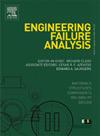Experimental study on dynamic performance and wear law of fixed frog sections on heavy-haul lines
IF 5.7
2区 工程技术
Q1 ENGINEERING, MECHANICAL
引用次数: 0
Abstract
This study presents a comprehensive investigation into the dynamic performance and wear characteristics of heavy-haul trains negotiating fixed frog sections. Utilizing a No.12 fixed frog as the research subject, the experimental design incorporated four distinct axle loads and two operational directions to evaluate full-scale vehicle dynamics. The research methodology involved two primary phases: initial assessment of vertical and lateral forces on unworn fixed frogs, followed by derailment coefficient and wheel load reduction rate calculations to analyze dynamic behavior under varying operational conditions. Subsequently, vertical force measurements were conducted across five progressive wear stages to establish correlations between wheel-frog interaction forces and wear progression. The experimental results reveal that maximum vertical and lateral forces on unworn fixed frogs consistently occur at the nose rail position, 0.75–1.25 m from the theoretical point. Notably, the peak vertical force exceeds 150 % of the static load, identifying this location as a critical stress concentration zone. Wear progression analysis demonstrates a non-linear relationship between vertical force and wear depth, characterized by initial rapid increase, subsequent slight decrease, and final accelerated growth. Critical wear thresholds were identified at 4 mm (initiation of stable wear) and 7 mm (transition to severe wear). Based on vertical force analysis, recommended wear limits for double-track railways are proposed: 8 mm for facing direction operations and 10 mm for trailing direction operations. These findings provide significant insights for mitigating fatigue damage and optimizing maintenance strategies for fixed frog sections in heavy-haul railway systems, ultimately contributing to enhanced operational safety and extended service life.
重载线路固蛙段动力性能及磨损规律试验研究
本文对重载列车通过固定蛙形断面的动力性能和磨损特性进行了全面的研究。实验设计以12号固定蛙为研究对象,采用四种不同的轴载荷和两种操作方向来评估全尺寸车辆动力学。研究方法包括两个主要阶段:初始评估未磨损固定蛙蛙的垂直和侧向力,然后计算脱轨系数和轮载减少率,以分析不同操作条件下的动态行为。随后,在五个渐进磨损阶段进行垂直力测量,以建立轮蛙相互作用力与磨损进展之间的相关性。实验结果表明,对未磨损固定蛙的最大垂直和侧向力始终发生在距理论点0.75-1.25 m的鼻轨位置。值得注意的是,峰值垂直力超过静载荷的150%,将该位置确定为临界应力集中区。磨损级数分析表明,垂直力与磨损深度呈非线性关系,表现为初始快速增大,随后略有减小,最后加速增大。临界磨损阈值确定为4mm(开始稳定磨损)和7mm(过渡到严重磨损)。基于竖向受力分析,提出了双线铁路的建议磨损极限:面向运行8mm,后向运行10mm。这些发现为减轻重载铁路系统中固定桥段的疲劳损伤和优化维护策略提供了重要见解,最终有助于提高运营安全性和延长使用寿命。
本文章由计算机程序翻译,如有差异,请以英文原文为准。
求助全文
约1分钟内获得全文
求助全文
来源期刊

Engineering Failure Analysis
工程技术-材料科学:表征与测试
CiteScore
7.70
自引率
20.00%
发文量
956
审稿时长
47 days
期刊介绍:
Engineering Failure Analysis publishes research papers describing the analysis of engineering failures and related studies.
Papers relating to the structure, properties and behaviour of engineering materials are encouraged, particularly those which also involve the detailed application of materials parameters to problems in engineering structures, components and design. In addition to the area of materials engineering, the interacting fields of mechanical, manufacturing, aeronautical, civil, chemical, corrosion and design engineering are considered relevant. Activity should be directed at analysing engineering failures and carrying out research to help reduce the incidences of failures and to extend the operating horizons of engineering materials.
Emphasis is placed on the mechanical properties of materials and their behaviour when influenced by structure, process and environment. Metallic, polymeric, ceramic and natural materials are all included and the application of these materials to real engineering situations should be emphasised. The use of a case-study based approach is also encouraged.
Engineering Failure Analysis provides essential reference material and critical feedback into the design process thereby contributing to the prevention of engineering failures in the future. All submissions will be subject to peer review from leading experts in the field.
 求助内容:
求助内容: 应助结果提醒方式:
应助结果提醒方式:


